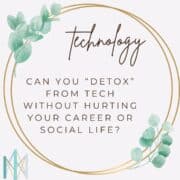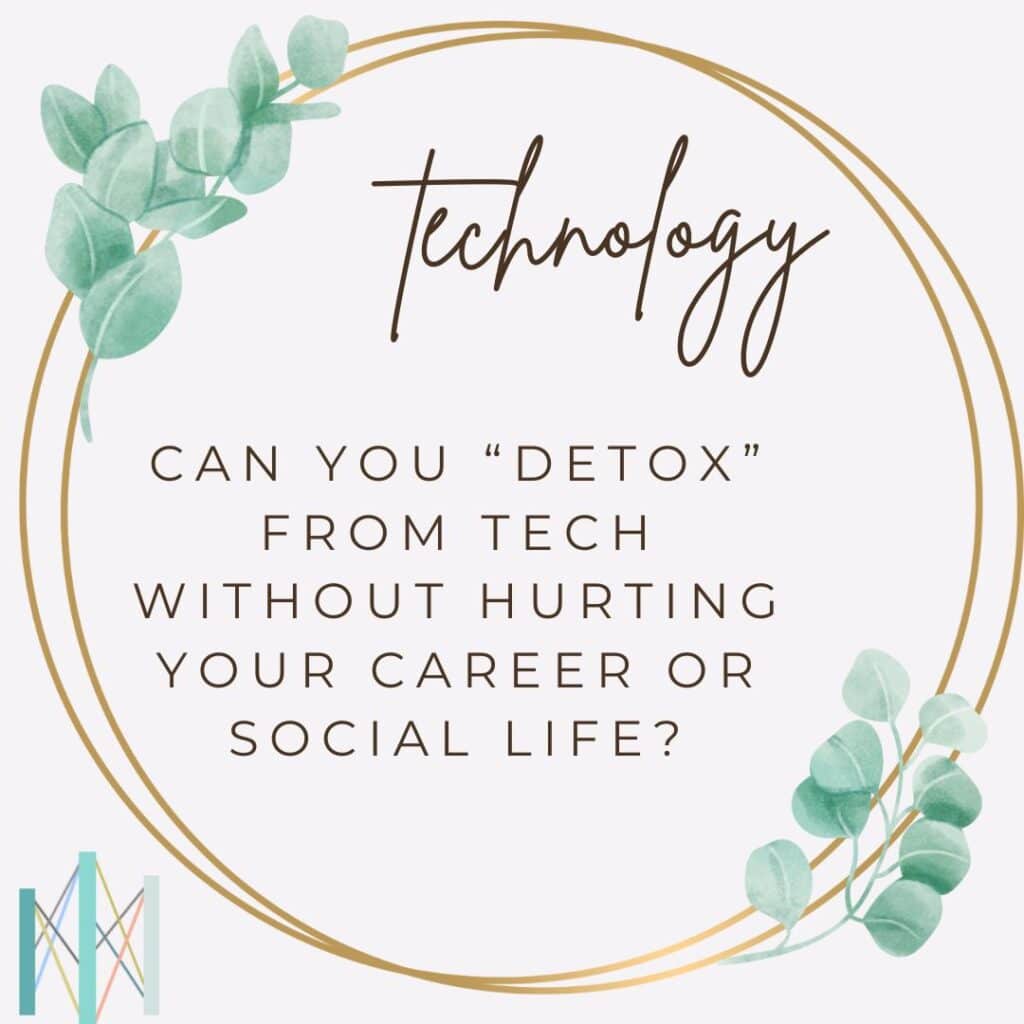

You might feel it—the creeping exhaustion from endless scrolling, the pressure to always be available, the realization that your day is shaped more by notifications than by your own intentions. Maybe you’re considering a digital detox, hoping to regain balance, focus, or just a little bit of peace.
But then reality sets in. Your job requires you to be online. Your friends and family stay connected through group chats, social media, and video calls. Networking happens on LinkedIn. Job searches require you to monitor emails constantly. If you’re a small business owner, your livelihood might even depend on social media engagement. So how do you step back from technology without disconnecting from the parts of life that matter?
A tech detox doesn’t have to mean deleting everything and going off the grid. It can be adapted to your personal needs, lifestyle, and career. Whether you’re feeling overwhelmed by digital overload, struggling to focus, or just want to be more present in your daily life, there’s a way to reset your relationship with technology without losing connection to your world.
Browse our Therapist Directory. We can help.
Why Are So Many People Considering a Tech Detox?
For many, the urge to step back from technology isn’t about rejection—it’s about recalibration. Technology has become so embedded in our work, social lives, and even mental health care that stepping away entirely isn’t realistic. But more and more people are recognizing that the way they engage with tech isn’t working for them.
Some of the most common reasons people seek a digital detox include:
- Feeling burnt out from constant digital engagement (especially in high-pressure industries like tech, finance, and creative fields).
- Struggling with work-life boundaries because email, Slack, and notifications create the expectation of 24/7 availability.
- Experiencing social media fatigue—the pressure to post, compare, or keep up with everyone’s curated lives.
- Wanting to be more present in personal relationships but finding it hard to unplug.
- Dealing with sleep or concentration issues caused by excessive screen time, endless scrolling, or dopamine-driven app designs.
- Parenting concerns, trying to model healthy tech use while also navigating personal and professional screen time demands.
- Misalignment with platform values – many people are rethinking which platforms they wish to be on and which companies they want to support in doing so.
Tech Use and Mental Health
Many people are increasingly concerned about how constant tech use affects their mental health. The endless notifications, social media comparisons, and pressure to be always “on” can lead to digital burnout, increased anxiety, and stress.
Studies have shown that excessive screen time, especially on social media, can contribute to feelings of isolation, low self-esteem, and depression. The addictive nature of digital platforms is designed to capture attention and provide instant gratification, which can lead to dopamine-driven behaviors that make it difficult to disconnect. This constant engagement can also disrupt sleep patterns, hinder concentration, and interfere with personal relationships.
As a result, more individuals are realizing the importance of stepping back from technology to protect their emotional and mental well-being and regain balance in their lives. A tech detox isn’t about eliminating technology—it’s about choosing how you want to engage with it in a way that supports your mental health, relationships, and career.
What Does a Digital Detox Look Like?
A digital detox isn’t one-size-fits-all. Some people find benefit in completely unplugging for a set period, while others take a more gradual or selective approach that better fits their daily responsibilities.
Here are a few ways to customize your own digital detox:
1. Time-Based Detox
- Limiting non-essential screen time to certain hours of the day (e.g., no screens before 9 a.m. or after 8 p.m.).
- Taking a 24-hour or weekend break from social media, streaming, or gaming.
- Trying a notification-free workday to increase focus and decrease interruptions.
2. Platform-Specific Detox
- Deleting or taking a break from a single platform (such as Instagram, TikTok, or LinkedIn).
- Setting app limits for scrolling-heavy platforms without eliminating them completely.
- Shifting from social media engagement to direct, in-person or text-based interactions.
3. Work-Life Integration Detox
- Establishing “no-email zones” in the evenings or on weekends.
- Setting clear expectations with colleagues about response times.
- Using tech-free meetings or breaks to reset during the workday.
4. Mindful Tech Use Instead of Elimination
- Keeping your phone but disabling non-essential notifications so you can engage on your own terms.
- Shifting from passive scrolling to active engagement, such as using social media for connection rather than consumption.
- Using grayscale mode on your phone to make it less visually stimulating.
Each of these approaches allows for a more intentional relationship with technology—without requiring complete disconnection.
Find a Therapist to Help with Tech Habits
Navigating a Tech Detox Across Different Lifestyles
Your relationship with technology is shaped by your career, identity, social needs, and responsibilities. What works for one person may not work for another. Here’s how a tech detox can look for different groups:
For People Working in Tech & High-Demand Jobs
If your job requires constant digital engagement, quitting screens isn’t an option—but creating better boundaries is.Taking scheduled tech-free breaks, managing work notifications intentionally, and setting clear expectations with your team can help you stay present without sacrificing career success.
For Small Business Owners & Entrepreneurs
Many small business owners feel pressure to be constantly online to engage clients, market their services, and stay competitive. Instead of stepping away entirely, consider outsourcing social media, setting defined engagement hours, or creating more structured content posting schedules to prevent burnout.
For Parents Trying to Model Healthy Tech Use
It can feel contradictory to limit screen time for kids while being glued to devices for work. Instead of focusing on restriction, model intentional tech use—such as engaging in screen-free family time, using tech for creativity rather than consumption, and setting designated times for checking emails.
For New Grads & Job Seekers
Staying digitally connected is essential for networking and job hunting, but it can also become overwhelming. A structured approach—such as limiting LinkedIn to specific hours, setting up job alerts instead of checking constantly, or using digital tools for efficiency rather than mindless scrolling—can help maintain balance.
For Social Media Influencers
If social media is part of your work or identity, stepping away entirely might not be an option. Instead of quitting, redefine your engagement—choose which platforms serve you best, take breaks from passive consumption, and engage with intention rather than obligation.
How Therapy Can Help You Create a Sustainable Relationship with Technology
If you’re struggling with tech overload, work-life imbalance, or compulsive social media use, therapy can help you:
- Identify your personal triggers for excessive screen use and create alternative coping strategies.
- Develop boundaries around technology that align with your career, relationships, and mental health.
- Reduce guilt and anxiety around unplugging, especially in work or social settings.
- Explore mindful tech use that allows for connection without feeling consumed.
- Address the emotional drivers behind digital overuse, such as stress, avoidance, or social pressure.
You don’t have to choose between staying connected and protecting your mental health—there is a middle ground. Therapy can help you find a tech routine that works for you, rather than against you.
If you’re ready to explore a more intentional and balanced relationship with technology, working with a therapist can provide personalized guidance and strategies to make it happen.
Browse our Therapist Directory. We want to help.



